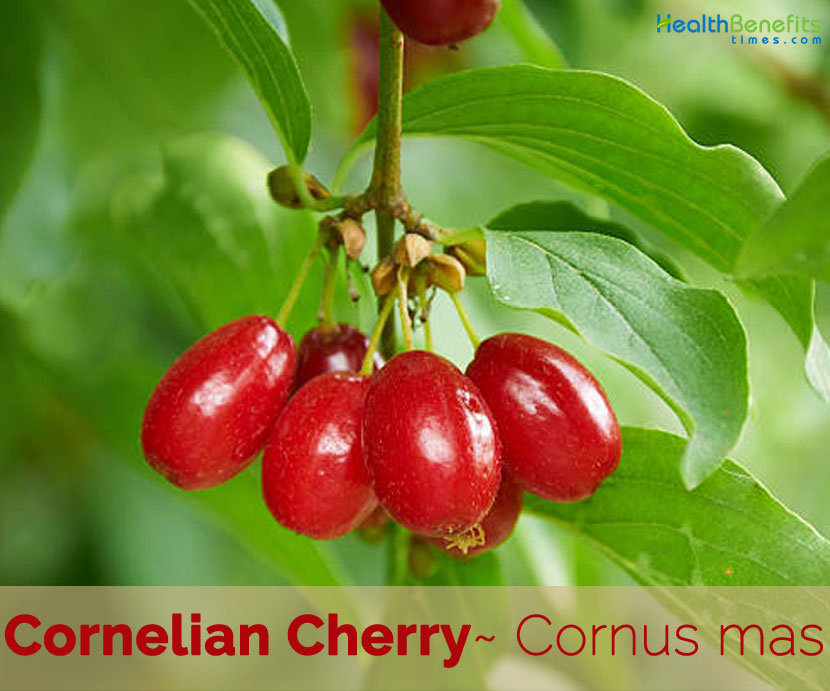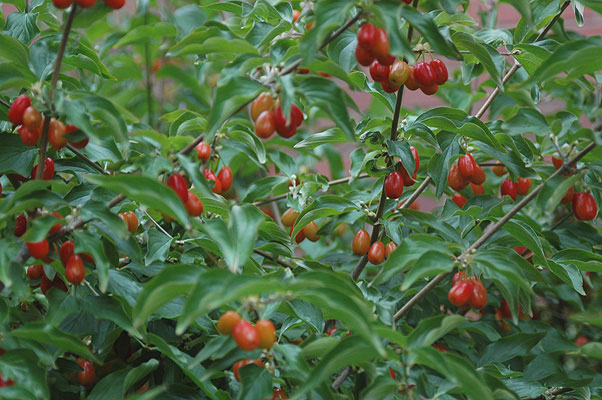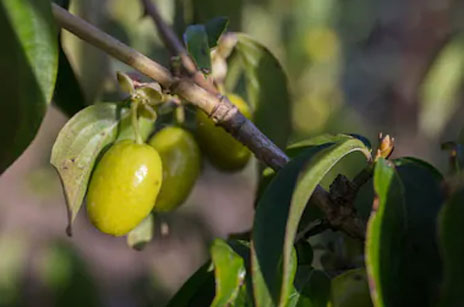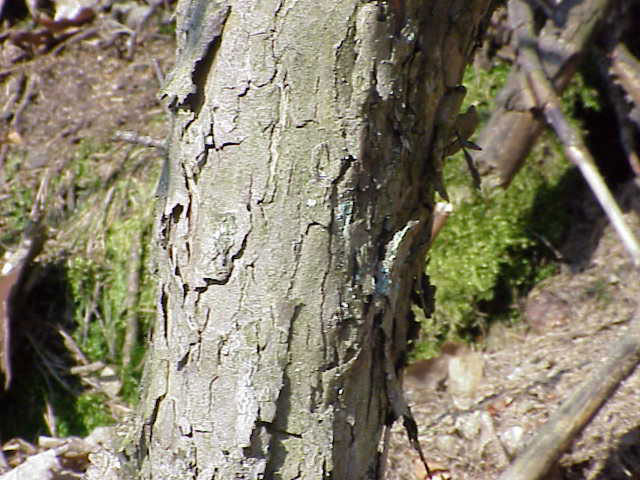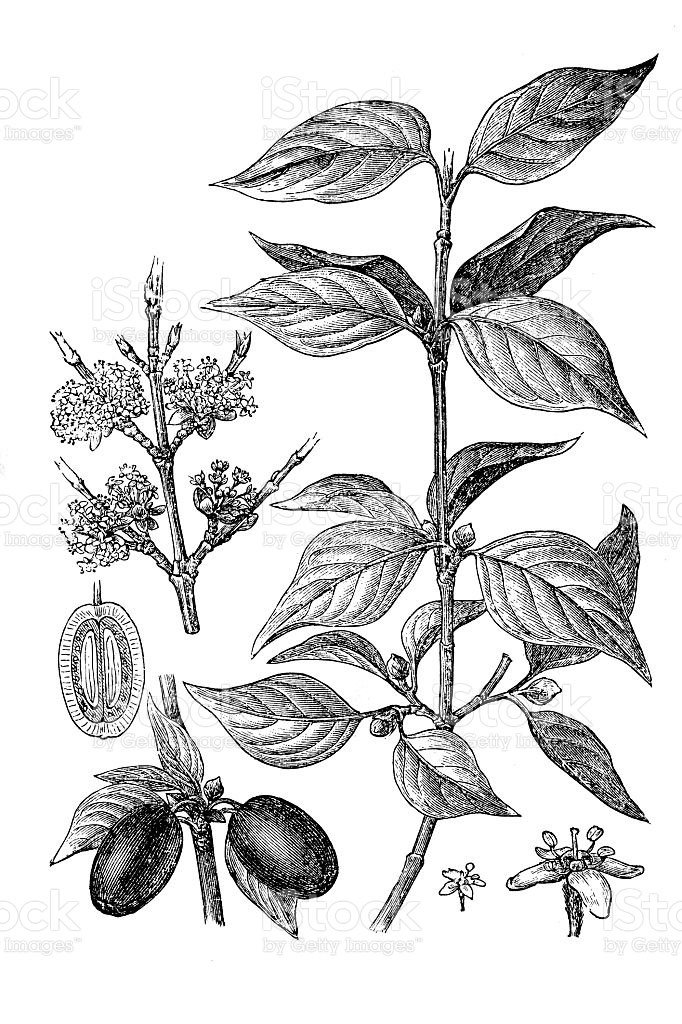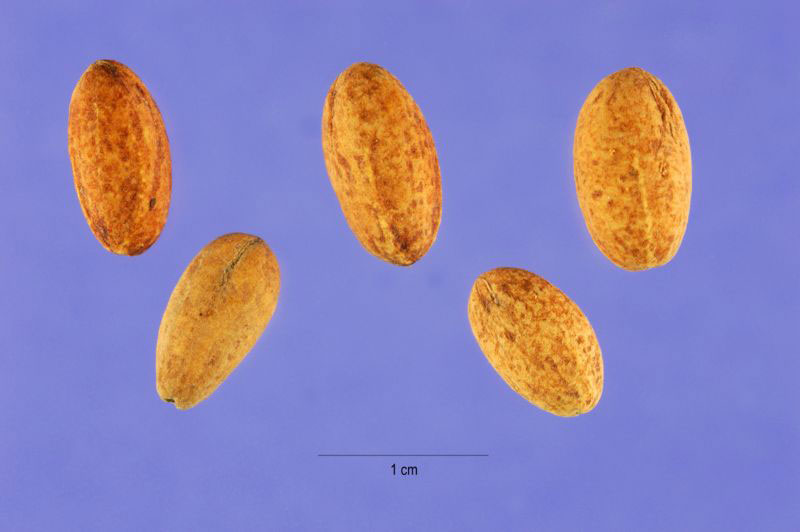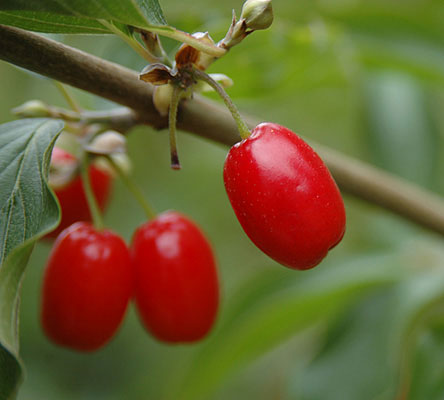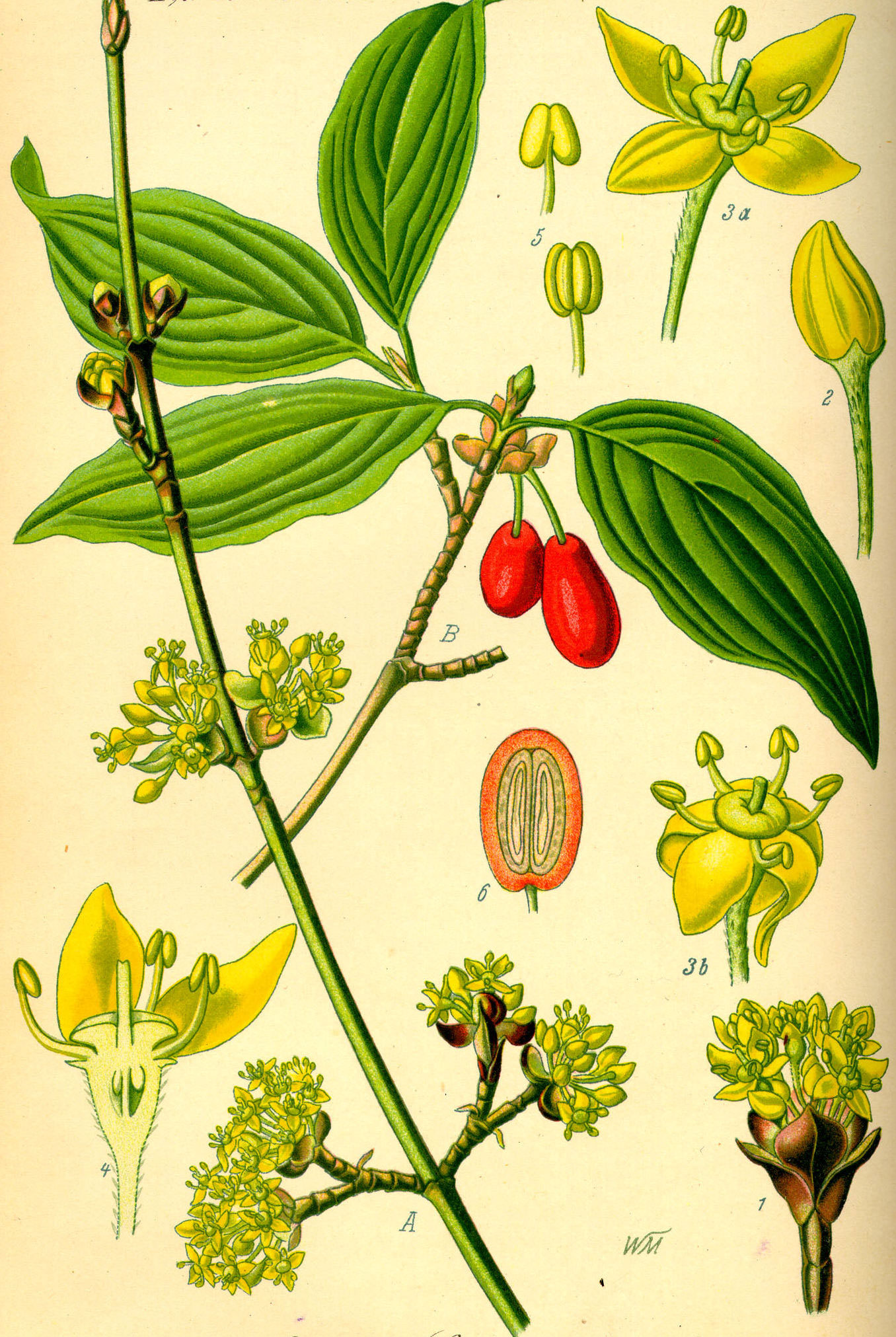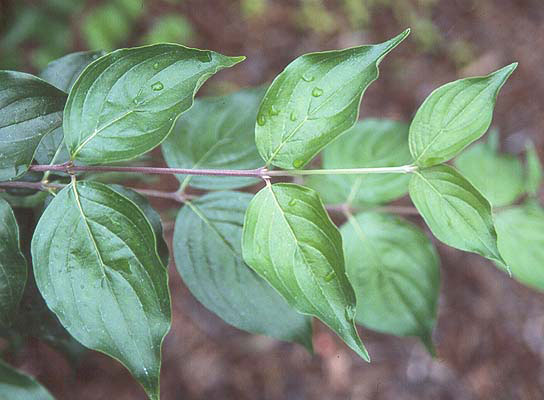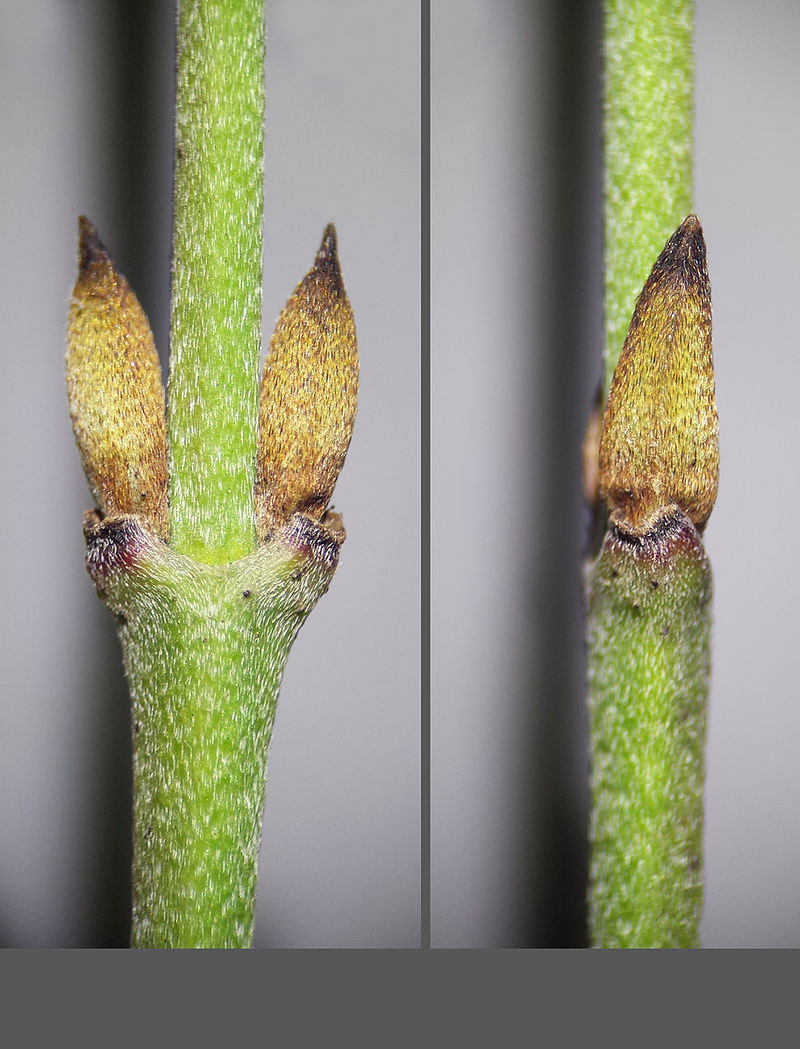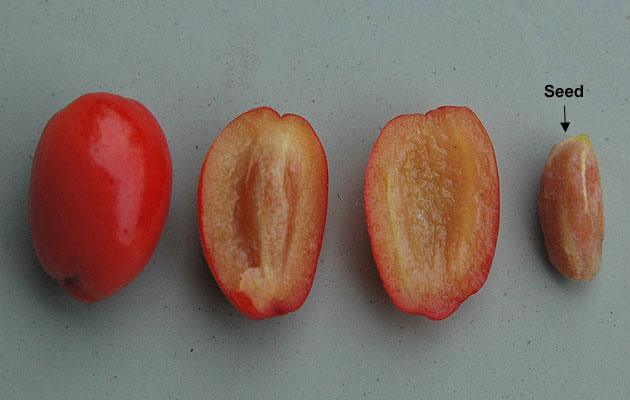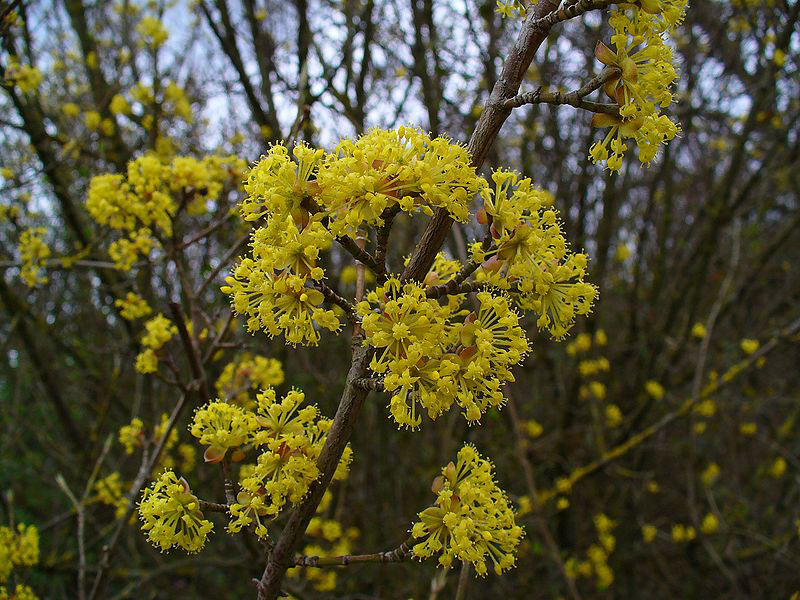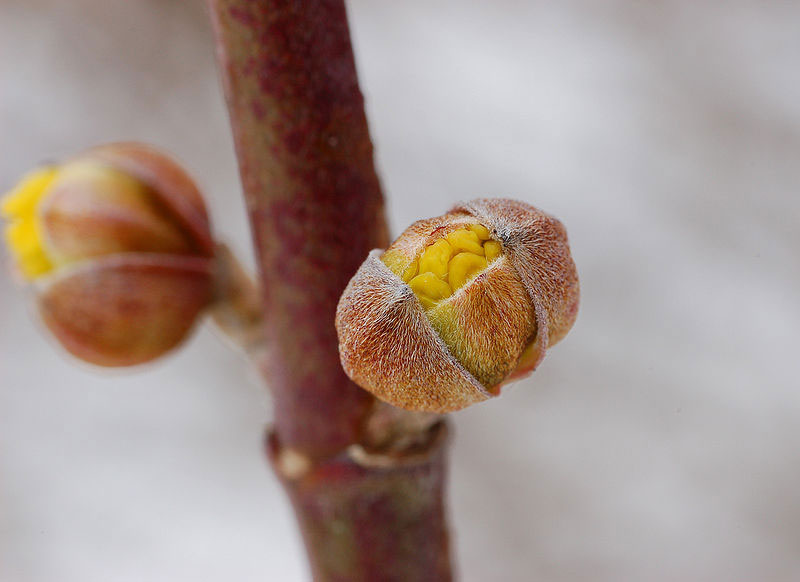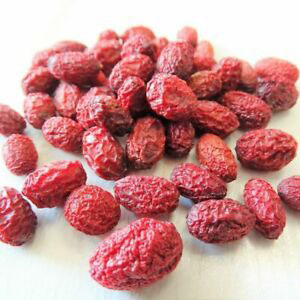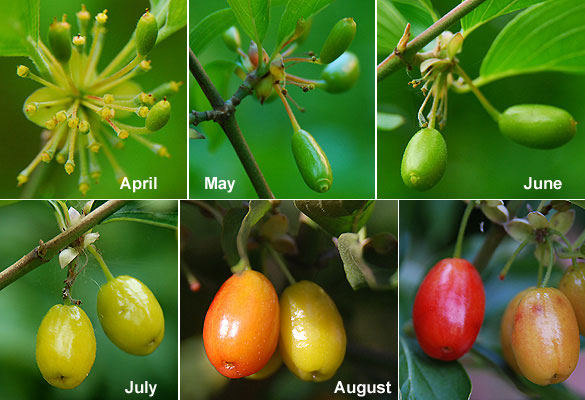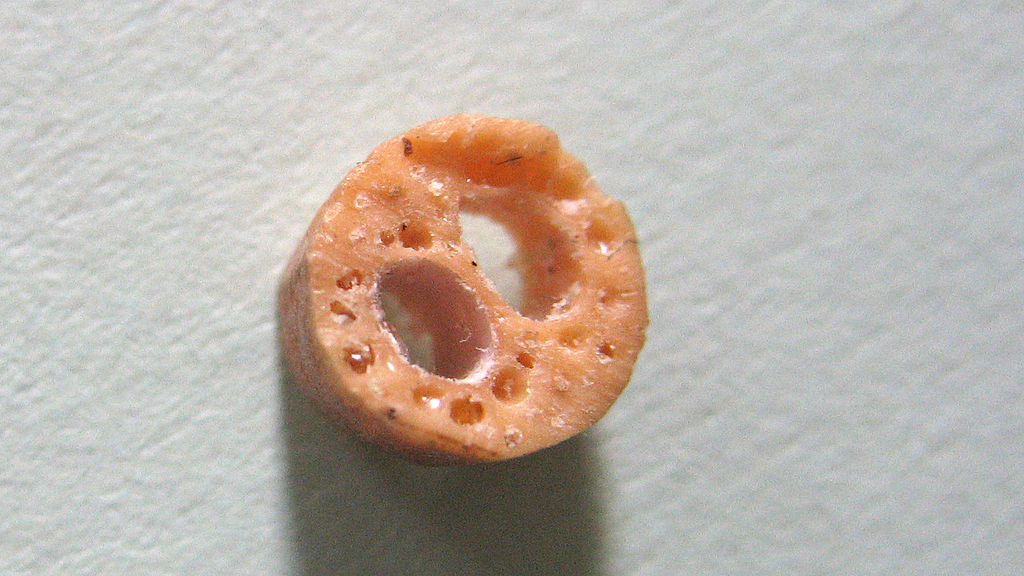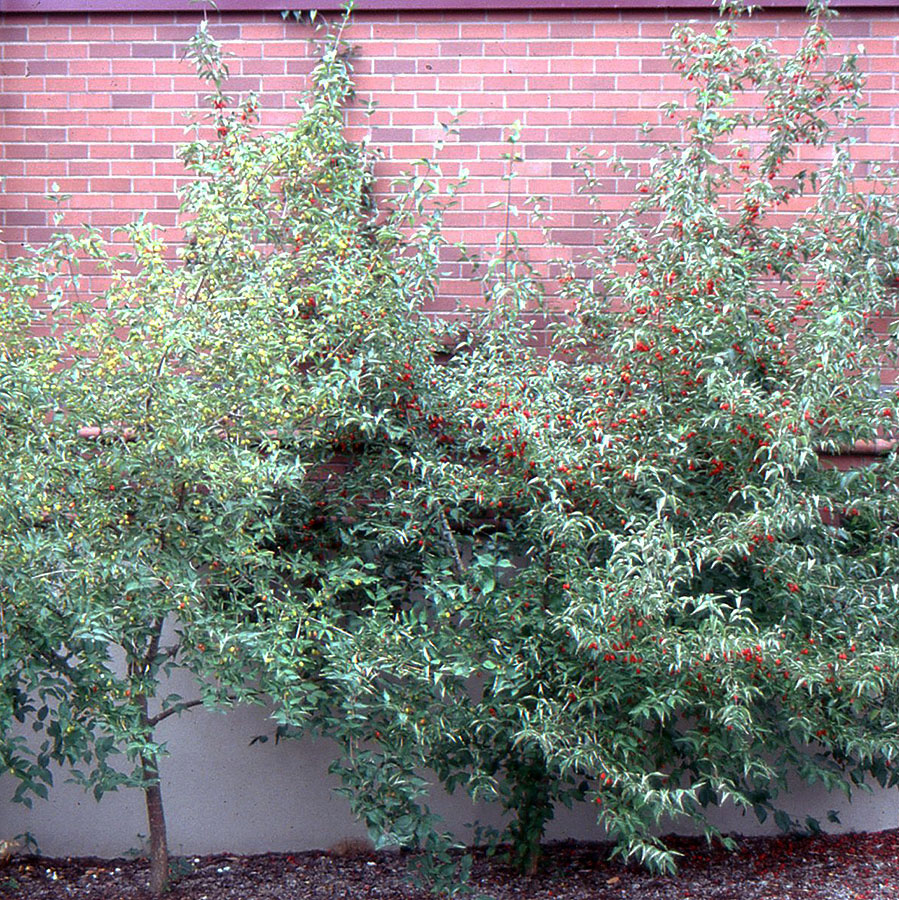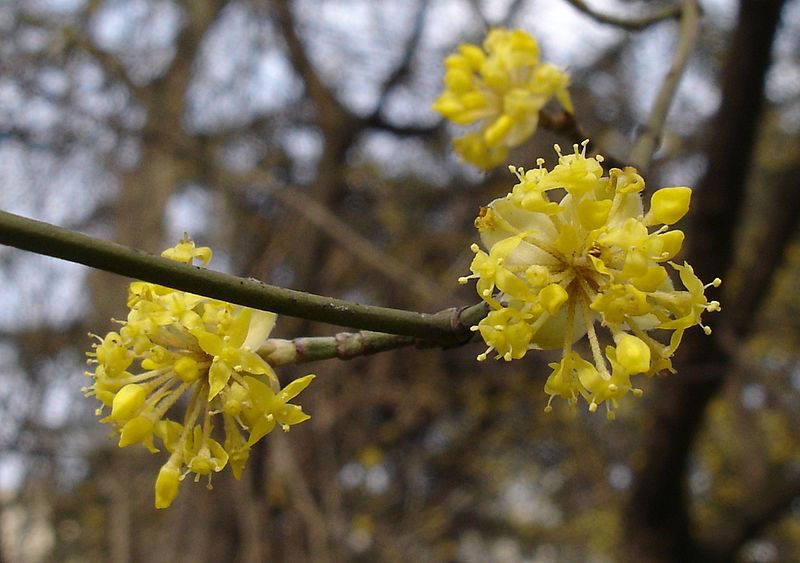| Cornelian cherry Quick Facts | |
|---|---|
| Name: | Cornelian cherry |
| Scientific Name: | Cornus mas |
| Origin | South western regions of Asia and southern Europe |
| Colors | Green when young turning to bright cherry red |
| Shapes | Spherical or elliptical, drupe, with an average length of 1.5–2 cm long and 1.5 cm in diameter |
| Taste | Tart sweet, sour and in some cases sweet-pineapple |
| Health benefits | Good for bowel complaints, fevers, dysentery, diarrhea, kidneys, hypertension, common cold, flu and cholera |
| Name | Cornelian cherry |
|---|---|
| Scientific Name | Cornus mas |
| Native | South western regions of Asia and southern Europe |
| Common Names | Common dogwood, Cornelian cherry, Male dogwood, Cornejo macho, Sorbet, Cornelian Cherry Dogwood, dogwood, European cornel, Cornel cherry |
| Name in Other Languages | Abkhazian: Абгыӡыр Albanian: Thana, thane Arabic: qaraniaan ‘uwrubiya (قرانيا أوروبية) Armenian: Chapki arakan (Ճապկի արական) Azerbaijani: Adi zoğal Basque: Zuhandor ar Bavarian: Diandling, Gäiwn Hartriegl, Koanelkiaschn Belarusian: Kizil zvyčajny (Кізіл звычайны) Bokmal: Vårkornell Bulgarian: Obiknoven dryan (Обикновен дрян) Cantonese: zhū yú (茱萸) Catalan: Corneller mascle Chechen: Stov (Стов) Chinese: Dà guǒ shānzhūyú (大果山茱萸) Croatian: Drenjine, Drijen, Drijenak, drin jarni, svida drin, svída dřín Czech: Dřín jarní, dřín obecný Danish: Kirsebær-Kornel, Kornelkirsebær Dutch: Gele Kornoelje English: Common dogwood, Cornelian cherry, Male dogwood, Cornejo macho, Sorbet, Cornelian Cherry Dogwood, dogwood, European cornel, Cornel cherry Esperanto: Karneca kornuso Finnish: Punamarjakanukka French: Cornouiller male, Cornouiller sauvage, Cornouille, aournier, bois de fer, cormier, cornier, cornier sauvage, corniolay, cornouiller des bois, cornouiller des haies, courgelier, fusilier, savignon Georgian: Shvindi (შვინდი),chveulebrivi shindi (ჩვეულებრივი შინდი) German: Dirndl Strauch, Herlitze, Dürlitze, Gelber Hartriegel, Hirlnuss, Kornelle, Kornelkirsche, Tierlibaum, Gelber Hornstrauch, Dirlitz, Dirndlbaum, Gelbhartriegel, Greek: Krána (Κράνα) Hungarian: Húsos som Irish: Coirnéilean Italian: Corniolo, Cornolaro, corniolo maschio, crognolo Japanese: Se iyousanshuyu (セ イヨウサンシュユ), Seiyou sanjuu Lak: Junav (Жунав) Lombard: Cornàl Lithuanian: Geltonoji sedula, Geltonžiedė sedula Macedonian: Dren (Дрен), običen dren (обичен дрен) Manx: Billey cornel Norwegian: Bærkornell, vårkornell Occitan: Cournié Persian: زغال اخته, Pichard: Cornilho Polish: Dereń jadalny, Dereń właściwy Portuguese: Cornelian cereja, corniso, cornizo Romanian: Corn Russian: Kizil mužskoj (Кизил мужской), Kizil obyknovennyy (Кизил обыкновенный), Doren muzhskoy (Дёрен мужской), Kizil muzhskoy (Кизил мужской) Serbian: Dren (Дрен), Drenjina (Дрењина) Serbo Croatian: Dren, Drijen, Drijenak Shambala: Dren, Drijen, Drijenak Slovak: Drieň obyčajný Slovenian: Rumeni dren Spanish: Cornejo común, Cornejo macho, Corno Europeo, cornejo, cornizo, cuerno Swedish: Körsbärskornell Turkish: Kızılcık, Ergen, Ergençiçeği, Kiren, Upper Sorbian: Drijenak Ukrainian: Deren spravzhniy (Дерен справжній), Kyzyl spravzhniy (Кизил справжній), Kyzyl (Кизил), Kizil (Кизиль) Venetian: Cornolaro, Cornołaro Welsh: Cwyrosyn y ceirios |
| Plant Growth Habit | Medium to large, slow-growing, deciduous, multi steamed shrub or small tree |
| Growing Climates | Woodlands, especially in calcareous soils, undergrowth in light, mainly oak and hornbeam forests, also at forest edges and in shrubby thickets on slopes |
| Soil | Easily grown in average, medium, well-drained soil in full sun to part shade. Prefers moist, organically rich soils |
| Plant Size | 20-25 ft. ( 6-8m) high, spreading to 15 ft. (4.5 m) and short bole is usually up to 25cm in diameter, occasionally to 45cm |
| Crown | Regular, bushy, hemispherical, and may expand more horizontally up to 5m |
| Bark | Grey-brownish, peeling off in scaly flakes like crocodile skin |
| Trunk | Straight, sometimes with sinuous or multiple stems, the branches ends often drooping |
| Twigs | Slender, glabrous, purplish red and green, turn brown the second year, pith white, leaf buds slender and pointed, flower buds much larger and round |
| Shoot | The young shoots are hairy grey-greenish, becoming hairless later |
| Leaf | Arranged opposite to one another with a short stalk and measure about 4 cm to 10 cm in length and 2 cm to 4 cm in width. The shape of the leaves vary from ovate to oblong |
| Flowering season | February to March |
| Flower | Small hermaphrodite yellow flowers measuring about 5 mm to 10 mm in diameter. Each flower has four small yellow petals. These flowers appear in clusters of 10 to 25 flowers |
| Fruit Shape & Size | Spherical or elliptical, drupe, with an average length of 1.5–2 cm long and 1.5 cm in diameter and a weight of 1.6–2.6 g, containing a single seed |
| Fruit Color | Green when young turning to bright cherry red as they matures |
| Fruit Weight | Ranges from 2.09 to 9.17 g, depending on the plant genotype and cultivation conditions |
| Plant Parts Used | Fruit, bark, roots |
| Taste | Tart sweet, sour and in some cases sweet-pineapple |
| Season | September to October |
| Precautions |
|
Plant Description
Cornelian cherry is a light-demanding and medium to large, slow-growing, and deciduous, multi steamed shrub or small tree that normally grows about 20-25 ft. (6-8m) tall and spread up to 15 ft. (4.5 m) wide and short bole is usually up to 25 cm in diameter, occasionally to 45 cm. The crown is regular, bushy, hemispherical, and may expand more horizontally up to 5 m. The trunk is straight, sometimes with sinuous or multiple stems, the branches ends often drooping. The bark is grey-brownish, peeling off in scaly flakes like crocodile skin. The young shoots are hairy grey-greenish, becoming hair less lately. The plant is found growing in woodlands, especially in calcareous soils, undergrowth in light, mainly oak and hornbeam forests, also at forest edges and in shrubby thickets on slopes. The plant can be easily grown in average, medium, well-drained soil in full sun to part shade and normally prefers moist, organically rich soils. It also a long living tree, surviving up to 300 years.
Leaves
The plant bears deep brown branches, while the twigs are greenish. The leaves are arranged opposite to one another with a short stalk and measure about 4 cm to 10 cm in length and 2 cm to 4 cm in width. The shape of the leaves vary from ovate to oblong with an entire margin that is shortly acuminate and supplied with visible parallel veins. Leaves are dark green above and lighter below. They turn to mahogany red in autumn.
| Leaf arrangement | Opposite/sub opposite |
| Leaf type | Simple |
| Leaf margin | Entire |
| Leaf shape | Ovate |
| Leaf venation | Pinnate, bowed |
| Leaf type and persistence | Deciduous |
| Leaf blade length | 2 to 4 inches |
| Leaf color | Green |
| Fall color | Red |
| Fall characteristic | Showy |
Flowers
Cornelian cherry trees bear small hermaphrodite yellow flowers measuring about 5 mm to 10 mm in diameter. Each flower has four small yellow petals. These flowers appear in clusters of 10 to 25 flowers towards the end of winter sometime between February and March, much before the leaves of the new growth season appear.
| Flower color | Yellow |
| Flower Characteristics | Showy |
Fruits
Fertile flowers are followed by spherical or elliptical, drupe, with an average length of 1.5–2 cm long and 1.5 cm in diameter and a weight of 1.6–2.6 g with a smooth and shiny rind and containing a single seed. The fruit is edible when it falls and is spread by animals. Fruits are edible, although sour tasting fresh off the plant. Fruits may be used for making syrups and preserves.
| Fruit Shape | Oval |
| Fruit Length | 0.5 to 1 inch |
| Fruit covering | Fleshy |
| Fruit Color | Red, yellow |
| Fruit characteristics | Attracts birds, showy, fruit/leaves a litter problem |
Distribution
Cornelian cherry is native of the temperate zones of Eurasia, with a Pontic and Mediterranean distribution. It occurs from central and southern Europe (Pyrenees, France, Italy and Balkan Peninsula) to Asia Minor (Turkey, Caucasus). Though, it can also be commonly found all over Europe outside its natural range, as it has been exported for centuries first as a fruit and medicinal plant, then as an ornamental shrub, and is now naturalized in some countries. Though its natural northern limits are Belgium and Germany, it has been planted in colder regions: e.g. in Oslo, Corneli-cherry trees in parks and gardens ripen every year. It has also been exported to North America as a landscape ornamental, and to China as an ornamental tree and for medical uses.
Traditional uses and benefits of Cornelian cherry
- Bark and the fruit are astringent, febrifuge and nutritive.
- Astringent fruit is a good treatment for bowel complaints and fevers, whilst it is also used in the treatment of cholera.
- Flowers are used in the treatment of diarrhea.
- It has traditionally been used for curing diarrhea and dysentery.
- Consumption of these berries and therapeutic formulations made from them helps speedy recovery from numerous ailments and restore to normal health after the illnesses.
- Drinking the juice extracted from cornelian cherry berry can also promote recovery after a bout of severe diarrhea.
- Consuming these berries on a regular basis helps to boost the functioning of liver by exercising a potent hepato protective action.
- Eating cornelian cherry also promotes the functioning of the kidneys.
- Consumption of this fruit helps to promote urine production, thus supporting the normal functioning of the kidneys.
- Cornelian cherry also aids in lowering high blood pressure and is beneficial for people suffering from hypertension.
- This berry-like fruit also encourages detoxification of the entire body.
- It is perfect for preventing common cold and flu, as it consists of high levels of vitamin C.
- Fruits are used for treating a variety of health conditions, including fever and various complaints related to the bowel.
- These fruits are also used for treating cholera.
- Consumption of these cherries also helps to relieve the mucous membranes in the gastrointestinal (GI) tract, clear the body of infections and also restore our health.
- Small amount of edible oil can be extracted from the seeds.
- Seeds are roasted, ground into a powder and used as a coffee substitute.
Culinary Uses
- Fruit can be consumed raw, dried or used in preserves.
- Fully ripe fruit has a somewhat plum-like flavor and texture and is very nice eating, but the unripe fruit is rather astringent.
- It is rather low in pectin and so needs to be used with other fruit when making jam.
- At one time the fruit was kept in brine and used like olives.
- Small amount of edible oil can be extracted from the seeds.
- Seeds are roasted, ground into a powder and used as a coffee substitute.
- In Azerbaijan and Armenia, the fruit is used for distilling vodka, in Austria and German Alps is used for distilling Dirndlbrand.
- In Albania and Bosnia and Herzegovina it is distilled into Rakia.
- In Turkey and Iran, it is consumed with salt as a snack in summer, and traditionally drunk in a cold drink called kızılcık şerbeti.
- Cornus mas is also a traditional component of liquors, jams, comfitures and other fruit-based products
- The leaves can be used as a tea substitute.
Other facts
- Oil is obtained from the seed.
- A dye is obtained from the bark.
- The leaves are a good source of tannin.
- Wood is very hard; it is highly valued by turners.
- It is used for tools, machine parts, etc.
- Cornus mas was used from the seventh century BC onward by Greek craftsmen to construct spears, javelins and bows, the craftsmen considering it far superior to any other wood.
- Wood has been famously associated with weaponry.
- Bark of cornelian cherry trees was used to make a red dye, which is used to make fezzes.
- During full fruit bearing, 20–80 kg of fruits can be picked from one tree.
- The thin trunks make excellent walking sticks and canes.
References:
https://www.itis.gov/servlet/SingleRpt/SingleRpt?search_topic=TSN&search_value=565094#null
https://npgsweb.ars-grin.gov/gringlobal/taxonomydetail.aspx?id=11563
https://pfaf.org/user/plant.aspx?latinname=Cornus+mas
https://www.missouribotanicalgarden.org/PlantFinder/PlantFinderDetails.aspx?kempercode=c290
http://www.floracatalana.net/cornus-mas-l-
https://plants.usda.gov/core/profile?symbol=COMA21
https://landscapeplants.oregonstate.edu/plants/cornus-mas
https://davesgarden.com/guides/pf/go/31669/#b
https://edis.ifas.ufl.edu/st193
http://dendro.cnre.vt.edu/dendrology/syllabus/factsheet.cfm?ID=280
https://www.wikidata.org/wiki/Q158642
http://www.theplantlist.org/tpl1.1/record/kew-47432
https://en.wikipedia.org/wiki/Cornus_mas
https://gd.eppo.int/taxon/CRWMS
https://www.cabi.org/isc/datasheet/16302


